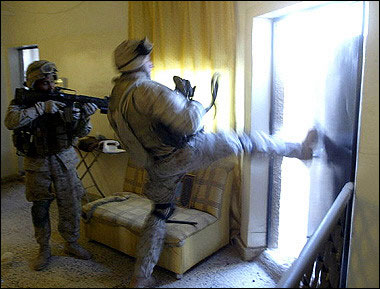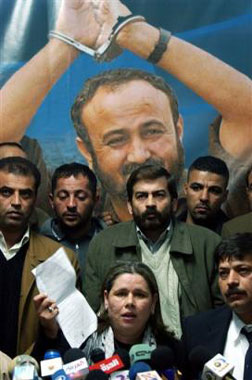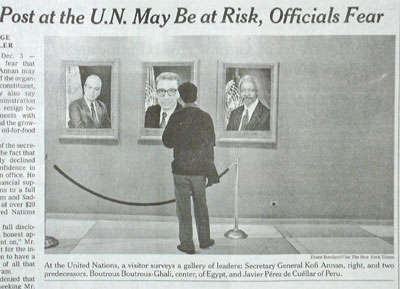Notes
Fort Knocks (Or, “Your House Is My House” — Part II)

I took a little heat a week and a half ago for raising the issue of the way U.S. troops were treating homes and property in Fallujah (Original post). While presenting an image of a couple soldiers sleeping in an occupied home, I asked what was appropriate in terms of making use of the property.
As an example of the response, a blog based in England called “th-inkwell” had this to say:
I’ll tell you what’s goddamned appropriate. Anything – ANYTHING – that is necessary to win. It’s appropriate to blow craters in the city, it’s appropriate to reduce walls to cement dust, it’s appropriate to storm mosques and schools, hospitals and private homes – in fact, anywhere a murdering group of thugs is hiding – and kill or subdue them, in that order. If the building happens to sustain damage, it’s one of the costs of victory.
I understand the tendency to say that “war is war” and that I’m being naive. The problem, however, is that I was not simply basing the judgment of the treatment of property and infrastructure in Fallujah on my own sensibilities. Rather, it was based on terms established by the military itself. I’m sorry to contradict the folks who saw this engagement in terms of “win at all costs” (or, “reduce the place to dust”), but it was the expressed strategy of our own forces in Fallujah to, above all, secure the ultimate goodwill of the local (non-insurgent) population.
There were numerous statements supporting these objective in news accounts and Pentagon briefings leading up to the attack. For more concrete evidence of this mindset, however, one might also refer to the military’s own “Counterinsurgency Operations” field manual. Here are some excerpts:
In order to defeat an insurgent force, US forces must be able to separate insurgents from the population. At the same time, US forces must conduct themselves in a manner that enables them to maintain popular domestic support. Excessive or indiscriminant use of force is likely to alienate the local populace, thereby increasing support for insurgent forces. (From Section 2-66 — Rules of Engagement.)
Judicious application of the minimum destruction concept [is recommended] in view of the overriding requirements to minimize alienating the population. (For example, bringing artillery or air power to bear on a village from which sniper fire was received may neutralize insurgent action but will alienate the civilian population as a result of casualties among noncombatants.) (From Section 3.43 — Defensive Operations.)
Infrastructure protection and repair/rehabilitation (for example, electrical power and water, electrical pole repair teams) are critical both for improving the populations’ physical well-being as well as for the positive psychological effect it creates. The electrical grid is a good confidence target (very visible), and there is no effect equivalent to the lights going out. “Turning on the lights” in Port-au-Prince contributed to reducing criminal activity (as measured by the murder rate) by about 40 percent in a two-month period (observed in Haiti). (From Section C-37 – Lessons Observed During Past Operations.)
So, how successful was the military in adhering to its own set of terms (including protection of that vital electrical grid)?
According to this report in Wednesday’s NYTimes:
The full extent of the damage inflicted by American bombs, tanks and artillery is only now becoming apparent. The number of buildings destroyed in the fighting is far higher than 200, the figure released last week by the Iraqi prime minister, Ayad Allawi, engineers and commanders say. The city’s power lines are so badly damaged that in most of the city, they will have to be ripped out and rebuilt from scratch – a project that will take six months to a year, American engineers say. Damage to the city’s water and sewer pipes, already badly corroded before the invasion, is milder but will also take months to repair.
And then, there’s this from Reuters today:
More than 200,000 people who fled Falluja ahead of the U.S. offensive have yet to return and many are in desperate need of aid, with temperatures in Iraq heading toward freezing, a new U.N. emergency report says.
Figures compiled by the International Organization for Migration show that 210,600 people, or more than 35,000 families, took refuge in towns and villages around Falluja in the build up to the U.S. assault, launched on Nov. 8.
Nearly all those people remain outside the city, where the population was estimated at 250,000-300,000 before the attack.
U.S. forces are maintaining a cordon around Falluja as sporadic fighting continues and are preventing refugees from returning, saying they want to stagger the return so that basic facilities can be restored before people go home.
Most areas of the city remain without power, water, sewage and other basic services and it is expected to take much longer than previously thought to start reconstruction as hundreds of buildings are completely destroyed.
On the other hand, perhaps my friend in England is right — meaning that the military’s “hearts and minds” strategy was just a smoke screen. Certainly, it wouldn’t surprise me if the true intention of Cheney, Bush and Rumsfeld was to skip all that messy “nation building” business, and just turn the entire Sunni Triangle into a parking lot.
Just one more point: Because I’m on the “image beat,” I’ve been very disappointed in the minimal visual coverage of the devastation in Fallujah (at least, so far). Gratefully, the NYTimes has been a notable exception. Here, for example, is a slideshow of the aftermath from their Multimedia section (link).
(photo:– AFP/Mehdi Fedouach on Wed Dec 1)


Reactions
Comments Powered by Disqus